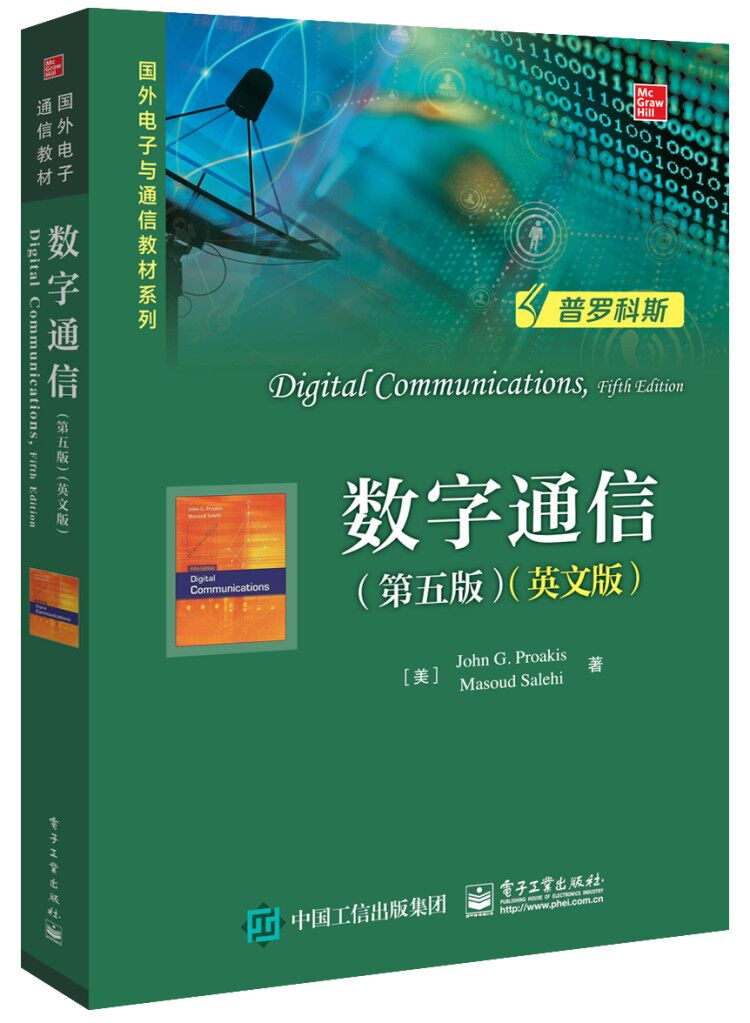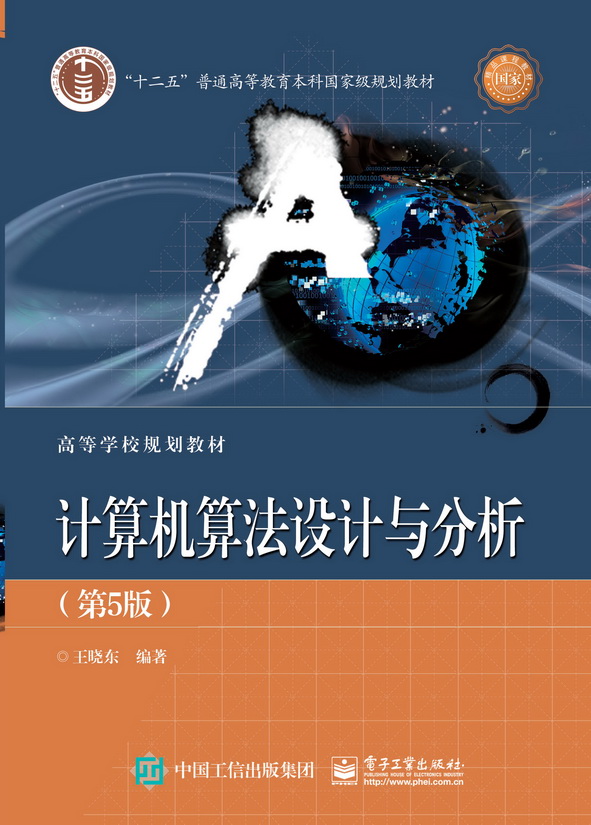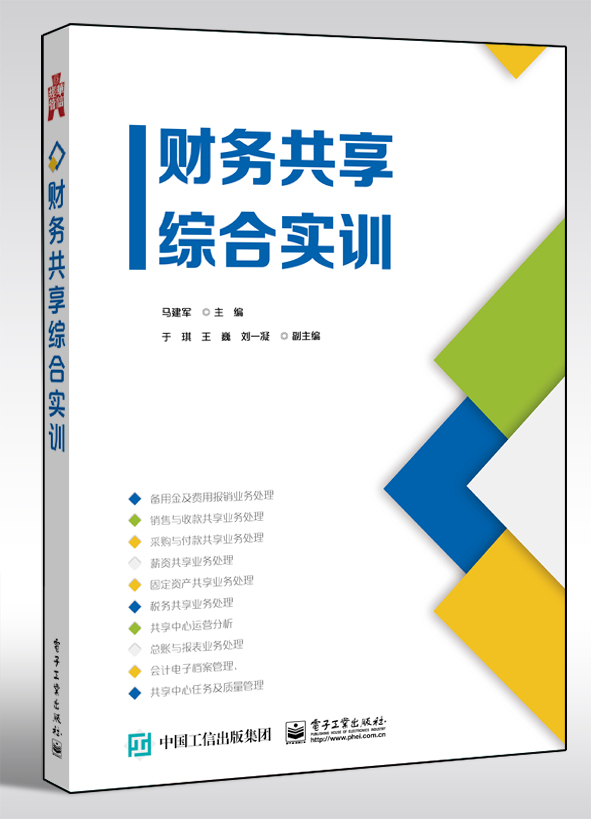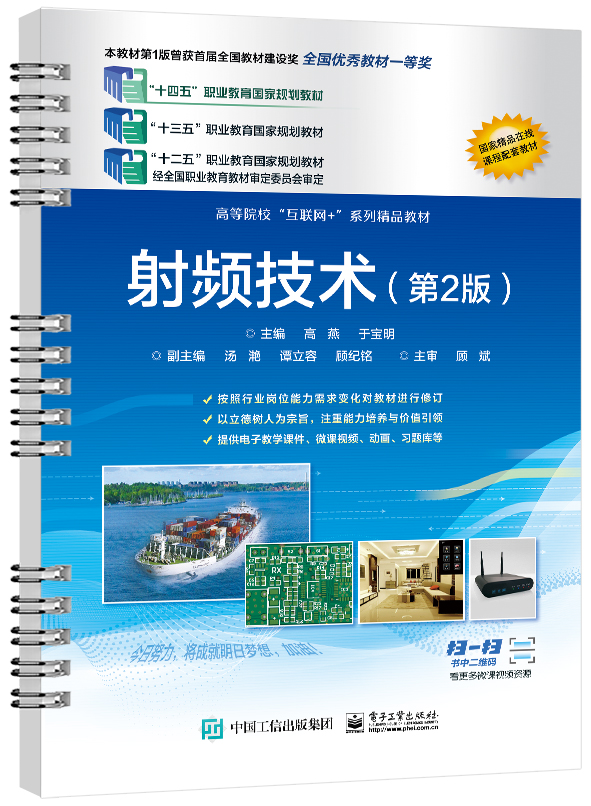数字通信(第五版)(英文版)
丛 书 名:
国外电子与通信教材系列
作 译 者:John G. Proakis(普罗科斯),Masoud Salehi(萨利希)
出 版 日 期:2019-10-01
书 代 号:G0367510
I S B N:9787121367519
图书简介:
本书是数字通信领域的一本优秀教材,既论述了数字通信的基本理论,又对数字通信的新技术进行了比较深入的分析。本书采用信号空间、随机过程的级数展开和等效低通等分析方法,根据最佳接收准则,先后讨论并分析了在加性高斯白噪声(AWGN)信道、带限信道(有符号间干扰和加性噪声)和多径衰落信道三种基本的典型信道条件下的数字信号可靠高效传输及最佳接收问题;从信号传输角度介绍了通信信号、数字调制、自适应均衡、多天线系统和最佳接收等内容;从信息传输角度介绍了信息论基础、信道容量和信道编码等内容。
-
配 套 资 源
本书资源
本书暂无资源 -
图 书 内 容
内容简介
本书是数字通信领域的一本优秀教材,既论述了数字通信的基本理论,又对数字通信的新技术进行了比较深入的分析。本书采用信号空间、随机过程的级数展开和等效低通等分析方法,根据最佳接收准则,先后讨论并分析了在加性高斯白噪声(AWGN)信道、带限信道(有符号间干扰和加性噪声)和多径衰落信道三种基本的典型信道条件下的数字信号可靠高效传输及最佳接收问题;从信号传输角度介绍了通信信号、数字调制、自适应均衡、多天线系统和最佳接收等内容;从信息传输角度介绍了信息论基础、信道容量和信道编码等内容。图书详情
ISBN:9787121367519开 本:16开页 数:1168字 数:1635.0本书目录
Preface Chapter 1 Introduction 1 1.1 Elements of a Digital Communication System 1 1.2 Communication Channels and Their Characteristics 3 1.3 Mathematical Models for Communication Channels 10 1.4 A Historical Perspective in the Development of Digital Communications 12 1.5 Overview of the Book 15 1.6 Bibliographical Notes and References 15 Chapter 2 Deterministic and Random Signal Analysis 17 2.1 Bandpass and Lowpass Signal Representation 18 2.1–1 Bandpass and Lowpass Signals / 2.1–2 Lowpass Equivalent of Bandpass Signals / 2.1–3 Energy Considerations / 2.1–4 Lowpass Equivalent of a Bandpass System 2.2 Signal Space Representation of Waveforms 28 2.2–1 Vector Space Concepts / 2.2–2 Signal Space Concepts / 2.2–3 Orthogonal Expansions of Signals /2.2–4 Gram-Schmidt Procedure 2.3 Some Useful Random Variables 40 2.4 Bounds on Tail Probabilities 56 2.5 Limit Theorems for Sums of Random Variables 63 2.6 Complex Random Variables 63 2.6–1 Complex Random Vectors 2.7 Random Processes 66 2.7–1 Wide-Sense Stationary Random Processes / 2.7–2 Cyclostationary Random Processes / 2.7–3 Proper and Circular Random Processes / 2.7–4 Markov Chains 2.8 Series Expansion of Random Processes 74 2.8–1 Sampling Theorem for Band-Limited Random Processes / 2.8–2 The Karhunen-Loève Expansion 2.9 Bandpass and Lowpass Random Processes 78 2.10 Bibliographical Notes and References 82 Problems 82 Chapter 3 Digital Modulation Schemes 95 3.1 Representation of Digitally Modulated Signals 95 3.2 Memoryless Modulation Methods 97 3.2–1 Pulse Amplitude Modulation (PAM) / 3.2–2 Phase Modulation / 3.2–3 Quadrature Amplitude Modulation / 3.2–4 Multidimensional Signaling 3.3 Signaling Schemes with Memory 114 3.3–1 Continuous-Phase Frequency-Shift Keying (CPFSK) / 3.3–2 Continuous-Phase Modulation (CPM) 3.4 Power Spectrum of Digitally Modulated Signals 131 3.4–1 Power Spectral Density of a Digitally Modulated Signal with Memory / 3.4–2 Power Spectral Density of Linearly Modulated Signals / 3.4–3 Power Spectral Density of Digitally Modulated Signals with Finite Memory / 3.4–4 Power Spectral Density of Modulation Schemes with a Markov Structure / 3.4–5 Power Spectral Densities of CPFSK and CPM Signals 3.5 Bibliographical Notes and References 148 Problems 148 Chapter 4 Optimum Receivers for AWGN Channels 160 4.1 Waveform and Vector Channel Models 160 4.1–1 Optimal Detection for a General Vector Channel 4.2 Waveform and Vector AWGN Channels 167 4.2–1 Optimal Detection for the Vector AWGN Channel / 4.2–2 Implementation of the Optimal Receiver for AWGN Channels / 4.2–3 A Union Bound on the Probability of Error of Maximum Likelihood Detection 4.3 Optimal Detection and Error Probability for Band-Limited Signaling 188 4.3–1 Optimal Detection and Error Probability for ASK or PAM Signaling / 4.3–2 Optimal Detection and Error Probability for PSK Signaling / 4.3–3 Optimal Detection and Error Probability for QAM Signaling / 4.3–4 Demodulation and Detection 4.4 Optimal Detection and Error Probability for Power-Limited Signaling 203 4.4–1 Optimal Detection and Error Probability for Orthogonal Signaling / 4.4–2 Optimal Detection and Error Probability for Biorthogonal Signaling / 4.4–3 Optimal Detection and Error Probability for Simplex Signaling 4.5 Optimal Detection in Presence of Uncertainty: Noncoherent Detection 210 4.5–1 Noncoherent Detection of Carrier Modulated Signals / 4.5–2 Optimal Noncoherent Detection of FSK Modulated Signals / 4.5–3 Error Probability of Orthogonal Signaling with Noncoherent Detection / 4.5–4 Probability of Error for Envelope Detection of Correlated Binary Signals / 4.5–5 Differential PSK (DPSK) 4.6 A Comparison of Digital Signaling Methods 226 4.6–1 Bandwidth and Dimensionality 4.7 Lattices and Constellations Based on Lattices 230 4.7–1 An Introduction to Lattices / 4.7–2 Signal Constellations from Lattices 4.8 Detection of Signaling Schemes with Memory 242 4.8–1 The Maximum Likelihood Sequence Detector 4.9 Optimum Receiver for CPM Signals 246 4.9–1 Optimum Demodulation and Detection of CPM /4.9–2 Performance of CPM Signals / 4.9–3 Suboptimum Demodulation and Detection of CPM Signals 4.10 Performance Analysis for Wireline and Radio Communication Systems 259 4.10–1 Regenerative Repeaters / 4.10–2 Link Budget Analysis in Radio Communication Systems 4.11 Bibliographical Notes and References 265 Problems 266 Chapter 5 Carrier and Symbol Synchronization 290 5.1 Signal Parameter Estimation 290 5.1–1 The Likelihood Function / 5.1–2 Carrier Recovery and Symbol Synchronization in Signal Demodulation 5.2 Carrier Phase Estimation 295 5.2–1 Maximum-Likelihood Carrier Phase Estimation /5.2–2 The Phase-Locked Loop / 5.2–3 Effect of Additive Noise on the Phase Estimate / 5.2–4 Decision-Directed Loops / 5.2–5 Non-Decision-Directed Loops 5.3 Symbol Timing Estimation 315 5.3–1 Maximum-Likelihood Timing Estimation /5.3–2 Non-Decision-Directed Timing Estimation 5.4 Joint Estimation of Carrier Phase and Symbol Timing 321 5.5 Performance Characteristics of ML Estimators 323 5.6 Bibliographical Notes and References 326 Problems 327 Chapter 6 An Introduction to Information Theory 330 6.1 Mathematical Models for Information Sources 331 6.2 A Logarithmic Measure of Information 332 6.3 Lossless Coding of Information Sources 335 6.3–1 The Lossless Source Coding Theorem / 6.3–2 Lossless Coding Algorithms 6.4 Lossy Data Compression 348 6.4–1 Entropy and Mutual Information for Continuous Random Variables / 6.4–2 The Rate Distortion Function 6.5 Channel Models and Channel Capacity 354 6.5–1 Channel Models / 6.5–2 Channel Capacity 6.6 Achieving Channel Capacity with Orthogonal Signals 367 6.7 The Channel Reliability Function 369 6.8 The Channel Cutoff Rate 371 6.8–1 Bhattacharyya and Chernov Bounds / 6.8–2 Random Coding 6.9 Bibliographical Notes and References 380 Problems 381 Chapter 7 Linear Block Codes 400 7.1 Basic De?nitions 401 7.1–1 The Structure of Finite Fields / 7.1–2 Vector Spaces 7.2 General Properties of Linear Block Codes 411 7.2–1 Generator and Parity Check Matrices / 7.2–2 Weight and Distance for Linear Block Codes / 7.2–3 The Weight Distribution Polynomial / 7.2–4 Error Probability of Linear Block Codes 7.3 Some Speci?c Linear Block Codes 420 7.3–1 Repetition Codes / 7.3–2 Hamming Codes /7.3–3 Maximum-Length Codes / 7.3–4 Reed-Muller Codes / 7.3–5 Hadamard Codes / 7.3–6 Golay Codes 7.4 Optimum Soft Decision Decoding of Linear Block Codes 424 7.5 Hard Decision Decoding of Linear Block Codes 428 7.5–1 Error Detection and Error Correction Capability of Block Codes / 7.5–2 Block and Bit Error Probability for Hard Decision Decoding 7.6 Comparison of Performance between Hard Decision and Soft Decision Decoding 436 7.7 Bounds on Minimum Distance of Linear Block Codes 440 7.7–1 Singleton Bound / 7.7–2 Hamming Bound /7.7–3 Plotkin Bound / 7.7–4 Elias Bound / 7.7–5 McEliece-Rodemich-Rumsey-Welch (MRRW) Bound /7.7–6 Varshamov-Gilbert Bound 7.8 Modi?ed Linear Block Codes 445 7.8–1 Shortening and Lengthening / 7.8–2 Puncturing and Extending / 7.8–3 Expurgation and Augmentation 7.9 Cyclic Codes 447 7.9–1 Cyclic Codes — De?nition and Basic Properties /7.9–2 Systematic Cyclic Codes / 7.9–3 Encoders for Cyclic Codes / 7.9–4 Decoding Cyclic Codes / 7.9–5 Examples of Cyclic Codes 7.10 Bose-Chaudhuri-Hocquenghem (BCH) Codes 463 7.10–1 The Structure of BCH Codes / 7.10–2 Decoding BCH Codes 7.11 Reed-Solomon Codes 471 7.12 Coding for Channels with Burst Errors 475 7.13 Combining Codes 477 7.13–1 Product Codes / 7.13–2 Concatenated Codes 7.14 Bibliographical Notes and References 482 Problems 482 Chapter 8 Trellis and Graph Based Codes 491 8.1 The Structure of Convolutional Codes 491 8.1–1 Tree, Trellis, and State Diagrams / 8.1–2 The Transfer Function of a Convolutional Code / 8.1–3 Systematic, Nonrecursive, and Recursive Convolutional Codes /8.1–4 The Inverse of a Convolutional Encoder and Catastrophic Codes 8.2 Decoding of Convolutional Codes 510 8.2–1 Maximum-Likelihood Decoding of Convolutional Codes — The Viterbi Algorithm / 8.2–2 Probability of Error for Maximum-Likelihood Decoding of Convolutional Codes 8.3 Distance Properties of Binary Convolutional Codes 516 8.4 Punctured Convolutional Codes 516 8.4–1 Rate-Compatible Punctured Convolutional Codes 8.5 Other Decoding Algorithms for Convolutional Codes 525 8.6 Practical Considerations in the Application of Convolutional Codes 532 8.7 Nonbinary Dual-k Codes and Concatenated Codes 537 8.8 Maximum a Posteriori Decoding of Convolutional Codes — The BCJR Algorithm 541 8.9 Turbo Codes and Iterative Decoding 548 8.9–1 Performance Bounds for Turbo Codes / 8.9–2 Iterative Decoding for Turbo Codes / 8.9–3 EXIT Chart Study of Iterative Decoding 8.10 Factor Graphs and the Sum-Product Algorithm 558 8.10–1 Tanner Graphs / 8.10–2 Factor Graphs / 8.10–3 The Sum-Product Algorithm / 8.10–4 MAP Decoding Using the Sum-Product Algorithm 8.11 Low Density Parity Check Codes 568 8.11–1 Decoding LDPC Codes 8.12 Coding for Bandwidth-Constrained Channels — Trellis Coded Modulation 571 8.12–1 Lattices and Trellis Coded Modulation /8.12–2 Turbo-Coded Bandwidth Ef?cient Modulation 8.13 Bibliographical Notes and References 589 Problems 590 Chapter 9 Digital Communication Through Band-Limited Channels 597 9.1 Characterization of Band-Limited Channels 598 9.2 Signal Design for Band-Limited Channels 602 9.2–1 Design of Band-Limited Signals for No Intersymbol Interference—The Nyquist Criterion / 9.2–2 Design of Band-Limited Signals with Controlled ISI—Partial-Response Signals / 9.2–3 Data Detection for Controlled ISI /9.2–4 Signal Design for Channels with Distortion 9.3 Optimum Receiver for Channels with ISI and AWGN 623 9.3–1 Optimum Maximum-Likelihood Receiver /9.3–2 A Discrete-Time Model for a Channel with ISI /9.3–3 Maximum-Likelihood Sequence Estimation (MLSE) for the Discrete-Time White Noise Filter Model /9.3–4 Performance of MLSE for Channels with ISI 9.4 Linear Equalization 640 9.4–1 Peak Distortion Criterion / 9.4–2 Mean-Square-Error (MSE) Criterion / 9.4–3 Performance Characteristics of the MSE Equalizer / 9.4–4 Fractionally Spaced Equalizers / 9.4–5 Baseband and Passband Linear Equalizers 9.5 Decision-Feedback Equalization 661 9.5–1 Coef?cient Optimization / 9.5–2 Performance Characteristics of DFE / 9.5–3 Predictive Decision-Feedback Equalizer / 9.5–4 Equalization at the Transmitter—Tomlinson–Harashima Precoding 9.6 Reduced Complexity ML Detectors 669 9.7 Iterative Equalization and Decoding—Turbo Equalization 671 9.8 Bibliographical Notes and References 673 Problems 674 Chapter 10 Adaptive Equalization 689 10.1 Adaptive Linear Equalizer 689 10.1–1 The Zero-Forcing Algorithm / 10.1–2 The LMS Algorithm / 10.1–3 Convergence Properties of the LMS Algorithm / 10.1–4 Excess MSE due to Noisy Gradient Estimates / 10.1–5 Accelerating the Initial Convergence Rate in the LMS Algorithm / 10.1–6 Adaptive Fractionally Spaced Equalizer—The Tap Leakage Algorithm / 10.1–7 An Adaptive Channel Estimator for ML Sequence Detection 10.2 Adaptive Decision-Feedback Equalizer 705 10.3 Adaptive Equalization of Trellis-Coded Signals 706 10.4 Recursive Least-Squares Algorithms for Adaptive Equalization 710 10.4–1 Recursive Least-Squares (Kalman) Algorithm / 10.4–2 Linear Prediction and the Lattice Filter 10.5 Self-Recovering (Blind) Equalization 721 10.5–1 Blind Equalization Based on the Maximum-Likelihood Criterion / 10.5–2 Stochastic Gradient Algorithms /10.5–3 Blind Equalization Algorithms Based on Second- and Higher-Order Signal Statistics 10.6 Bibliographical Notes and References 731 Problems 732 Chapter 11 Multichannel and Multicarrier Systems 737 11.1 Multichannel Digital Communications in AWGN Channels 737 11.1–1 Binary Signals / 11.1–2 M-ary Orthogonal Signals 11.2 Multicarrier Communications 743 11.2–1 Single-Carrier Versus Multicarrier Modulation / 11.2–2 Capacity of a Nonideal Linear Filter Channel / 11.2–3 Orthogonal Frequency Division Multiplexing (OFDM) / 11.2–4 Modulation and Demodulation in an OFDM System / 11.2–5 An FFT Algorithm Implementation of an OFDM System / 11.2–6 Spectral Characteristics of Multicarrier Signals / 11.2–7 Bit and Power Allocation in Multicarrier Modulation / 11.2–8 Peak-to-Average Ratio in Multicarrier Modulation / 11.2–9 Channel Coding Considerations in Multicarrier Modulation 11.3 Bibliographical Notes and References 759 Problems 760 Chapter 12 Spread Spectrum Signals for Digital Communications 762 12.1 Model of Spread Spectrum Digital Communication System 763 12.2 Direct Sequence Spread Spectrum Signals 765 12.2–1 Error Rate Performance of the Decoder /12.2–2 Some Applications of DS Spread Spectrum Signals / 12.2–3 Effect of Pulsed Interference on DS Spread Spectrum Systems / 12.2–4 Excision of Narrowband Interference in DS Spread Spectrum Systems /12.2–5 Generation of PN Sequences 12.3 Frequency-Hopped Spread Spectrum Signals 802 12.3–1 Performance of FH Spread Spectrum Signals in an AWGN Channel / 12.3–2 Performance of FH Spread Spectrum Signals in Partial-Band Interference / 12.3–3 A CDMA System Based on FH Spread Spectrum Signals 12.4 Other Types of Spread Spectrum Signals 814 12.5 Synchronization of Spread Spectrum Systems 815 12.6 Bibliographical Notes and References 823 Problems 823 Chapter 13 Fading Channels I: Characterization and Signaling 830 13.1 Characterization of Fading Multipath Channels 831 13.1–1 Channel Correlation Functions and Power Spectra / 13.1–2 Statistical Models for Fading Channels 13.2 The Effect of Signal Characteristics on the Choice of a Channel Model 844 13.3 Frequency-Nonselective, Slowly Fading Channel 846 13.4 Diversity Techniques for Fading Multipath Channels 850 13.4–1 Binary Signals / 13.4–2 Multiphase Signals / 13.4–3 M-ary Orthogonal Signals 13.5 Signaling over a Frequency-Selective, Slowly Fading Channel: The RAKE Demodulator 869 13.5–1 A Tapped-Delay-Line Channel Model / 13.5–2 The RAKE Demodulator / 13.5–3 Performance of RAKE Demodulator / 13.5–4 Receiver Structures for Channels with Intersymbol Interference 13.6 Multicarrier Modulation (OFDM) 884 13.6–1 Performance Degradation of an OFDM System due to Doppler Spreading / 13.6–2 Suppression of ICI in OFDM Systems 13.7 Bibliographical Notes and References 890 Problems 891 Chapter 14 Fading Channels II: Capacity and Coding 899 14.1 Capacity of Fading Channels 900 14.1–1 Capacity of Finite-State Channels 14.2 Ergodic and Outage Capacity 905 14.2–1 The Ergodic Capacity of the Rayleigh Fading Channel / 14.2–2 The Outage Capacity of Rayleigh Fading Channels 14.3 Coding for Fading Channels 918 14.4 Performance of Coded Systems In Fading Channels 919 14.4–1 Coding for Fully Interleaved Channel Model 14.5 Trellis-Coded Modulation for Fading Channels 929 14.5–1 TCM Systems for Fading Channels / 14.5–2 Multiple Trellis-Coded Modulation (MTCM) 14.6 Bit-Interleaved Coded Modulation 936 14.7 Coding in the Frequency Domain 942 14.7–1 Probability of Error for Soft Decision Decoding of Linear Binary Block Codes / 14.7–2 Probability of Error for Hard-Decision Decoding of Linear Block Codes / 14.7–3 Upper Bounds on the Performance of Convolutional Codes for a Rayleigh Fading Channel / 14.7–4 Use of Constant-Weight Codes and Concatenated Codes for a Fading Channel 14.8 The Channel Cutoff Rate for Fading Channels 957 14.8–1 Channel Cutoff Rate for Fully Interleaved Fading Channels with CSI at Receiver 14.9 Bibliographical Notes and References 960 Problems 961 Chapter 15 Multiple-Antenna Systems 966 15.1 Channel Models for Multiple-Antenna Systems 966 15.1–1 Signal Transmission Through a Slow Fading Frequency-Nonselective MIMO Channel / 15.1–2 Detection of Data Symbols in a MIMO System / 15.1–3 Signal Transmission Through a Slow Fading Frequency-Selective MIMO Channel 15.2 Capacity of MIMO Channels 981 15.2–1 Mathematical Preliminaries / 15.2–2 Capacity of a Frequency-Nonselective Deterministic MIMO Channel / 15.2–3 Capacity of a Frequency-Nonselective Ergodic Random MIMO Channel / 15.2–4 Outage Capacity / 15.2–5 Capacity of MIMO Channel When the Channel Is Known at the Transmitter 15.3 Spread Spectrum Signals and Multicode Transmission 992 15.3–1 Orthogonal Spreading Sequences / 15.3–2 Multiplexing Gain Versus Diversity Gain / 15.3–3 Multicode MIMO Systems 15.4 Coding for MIMO Channels 1001 15.4–1 Performance of Temporally Coded SISO Systems in Rayleigh Fading Channels / 15.4–2 Bit-Interleaved Temporal Coding for MIMO Channels / 15.4–3 Space-Time Block Codes for MIMO Channels / 15.4–4 Pairwise Error Probability for a Space-Time Code / 15.4–5 Space-Time Trellis Codes for MIMO Channels / 15.4–6 Concatenated Space-Time Codes and Turbo Codes 15.5 Bibliographical Notes and References 1021 Problems 1021 Chapter 16 Multiuser Communications 1028 16.1 Introduction to Multiple Access Techniques 1028 16.2 Capacity of Multiple Access Methods 1031 16.3 Multiuser Detection in CDMA Systems 1036 16.3–1 CDMA Signal and Channel Models / 16.3–2 The Optimum Multiuser Receiver / 16.3–3 Suboptimum Detectors / 16.3–4 Successive Interference Cancellation / 16.3–5 Other Types of Multiuser Detectors / 16.3–6 Performance Characteristics of Detectors 16.4 Multiuser MIMO Systems for Broadcast Channels 1053 16.4–1 Linear Precoding of the Transmitted Signals / 16.4–2 Nonlinear Precoding of the Transmitted Signals—The QR Decomposition / 16.4–3 Nonlinear Vector Precoding / 16.4–4 Lattice Reduction Technique for Precoding 16.5 Random Access Methods 1068 16.5–1 ALOHA Systems and Protocols / 16.5–2 Carrier Sense Systems and Protocols 16.6 Bibliographical Notes and References 1077 Problems 1078 Appendix A Matrices 1085 A.1 Eigenvalues and Eigenvectors of a Matrix 1086 A.2 Singular-Value Decomposition 1087 A.3 Matrix Norm and Condition Number 1088 A.4 The Moore–Penrose Pseudoinverse 1088 Appendix B Error Probability for Multichannel Binary Signals 1090 Appendix C Error Probabilities for Adaptive Reception of M-Phase Signals 1096 C.1 Mathematical Model for an M-Phase Signaling Communication System 1096 C.2 Characteristic Function and Probability Density Function of the Phase θ 1098 C.3 Error Probabilities for Slowly Fading Rayleigh Channels 1100 C.4 Error Probabilities for Time-Invariant and Ricean Fading Channels 1104 Appendix D Square Root Factorization 1107 References and Bibliography 1109 Index 1142展开前 言
P R E F A C E It is a pleasure to welcome Professor Masoud Salehi as a coauthor to the ?fth edition of Digital Communications. This new edition has undergone a major revision and reorganization of topics, especially in the area of channel coding and decoding. A new chapter on multiple-antenna systems has been added as well. The book is designed to serve as a text for a ?rst-year graduate-level course for students in electrical engineering. It is also designed to serve as a text for self-study and as a reference book for the practicing engineer involved in the design and analysis of digital communications systems. As to background, we presume that the reader has a thorough understanding of basic calculus and elementary linear systems theory and prior knowledge of probability and stochastic processes. Chapter 1 is an introduction to the subject, including a historical perspective and a description of channel characteristics and channel models. Chapter 2 contains a review of deterministic and random signal analysis, including bandpass and lowpass signal representations, bounds on the tail probabilities of random variables, limit theorems for sums of random variables, and random processes. Chapter 3 treats digital modulation techniques and the power spectrum of digitally modulated signals. Chapter 4 is focused on optimum receivers for additive white Gaussian noise (AWGN) channels and their error rate performance. Also included in this chapter is an introduction to lattices and signal constellations based on lattices, as well as link budget analyses for wireline and radio communication systems. Chapter 5 is devoted to carrier phase estimation and time synchronization methods based on the maximum-likelihood criterion. Both decision-directed and non-decision-directed methods are described. Chapter 6 provides an introduction to topics in information theory, including lossless source coding, lossy data compression, channel capacity for different channel models, and the channel reliability function. Chapter 7 treats linear block codes and their properties. Included is a treatment of cyclic codes, BCH codes, Reed-Solomon codes, and concatenated codes. Both soft decision and hard decision decoding methods are described, and their performance in AWGN channels is evaluated. Chapter 8 provides a treatment of trellis codes and graph-based codes, including convolutional codes, turbo codes, low density parity check (LDPC) codes, trellis codes for band-limited channels, and codes based on lattices. Decoding algorithms are also treated, including the Viterbi algorithm and its performance on AWGN channels, the BCJR algorithm for iterative decoding of turbo codes, and the sum-product algorithm. Chapter 9 is focused on digital communication through band-limited channels. Topics treated in this chapter include the characterization and signal design for band-limited channels, the optimum receiver for channels with intersymbol interference and AWGN, and suboptimum equalization methods, namely, linear equalization, decision-feedback equalization, and turbo equalization. Chapter 10 treats adaptive channel equalization. The LMS and recursive least-squares algorithms are described together with their performance characteristics. This chapter also includes a treatment of blind equalization algorithms. Chapter 11 provides a treatment of multichannel and multicarrier modulation. Topics treated include the error rate performance of multichannel binary signal and M-ary orthogonal signals in AWGN channels; the capacity of a nonideal linear ?lter channel with AWGN; OFDM modulation and demodulation; bit and power allocation in an OFDM system; and methods to reduce the peak-to-average power ratio in OFDM. Chapter 12 is focused on spread spectrum signals and systems, with emphasis on direct sequence and frequency-hopped spread spectrum systems and their performance. The bene?ts of coding in the design of spread spectrum signals is emphasized throughout this chapter. Chapter 13 treats communication through fading channels, including the characterization of fading channels and the key important parameters of multipath spread and Doppler spread. Several channel fading statistical models are introduced, with emphasis placed on Rayleigh fading, Ricean fading, and Nakagami fading. An analysis of the performance degradation caused by Doppler spread in an OFDM system is presented, and a method for reducing this performance degradation is described. Chapter 14 is focused on capacity and code design for fading channels. After introducing ergodic and outage capacities, coding for fading channels is studied. Bandwidth-ef?cient coding and bit-interleaved coded modulation are treated, and the performance of coded systems in Rayleigh and Ricean fading is derived. Chapter 15 provides a treatment of multiple-antenna systems, generally called multiple-input, multiple-output (MIMO) systems, which are designed to yield spatial signal diversity and spatial multiplexing. Topics treated in this chapter include detection algorithms for MIMO channels, the capacity of MIMO channels with AWGN without and with signal fading, and space-time coding. Chapter 16 treats multiuser communications, including the topics of the capacity of multiple-access methods, multiuser detection methods for the uplink in CDMA systems, interference mitigation in multiuser broadcast channels, and random access methods such as ALOHA and carrier-sense multiple access (CSMA). With 16 chapters and a variety of topics, the instructor has the ?exibility to design either a one- or two-semester course. Chapters 3, 4, and 5 provide a basic treatment of digital modulation/demodulation and detection methods. Channel coding and decoding treated in Chapters 7, 8, and 9 can be included along with modulation/demodulation in a one-semester course. Alternatively, Chapters 9 through 12 can be covered in place of channel coding and decoding. A second semester course can cover the topics of communication through fading channels, multiple-antenna systems, and multiuser communications. The authors and McGraw-Hill would like to thank the following reviewers for their suggestions on selected chapters of the ?fth edition manuscript: Paul Salama, Indiana University/Purdue University, Indianapolis; Dimitrios Hatzinakos, University of Toronto, and Ender Ayanoglu, University of California, Irvine. Finally, the ?rst author wishes to thank Gloria Doukakis for her assistance in typing parts of the manuscript. We also thank Patrick Amihood for preparing several graphs in Chapters 15 and 16 and Apostolos Rizos and Kostas Stamatiou for preparing parts of the Solutions Manual. 前 言 欢迎Masoud Salehi教授作为《数字通信》(第五版)的合著者。这一新版做了较大修订,重组了论题,特别是在信道编码和译码方面。同时增加了关于多天线系统的一章。 本书设计用来作为电子工程系高年级本科生和一年级研究生相关课程的教材,也适合从事数字通信系统设计的工程师作为自学课本和参考书。为更好地阅读本书,读者应具备基本的微积分、线性系统理论,以及概率论和随机过程等背景知识。 第1章是全书的导引,包括对信道特征和信道模型的描述、历史视角的回顾。 第2章是对确定信号和随机信号分析的复习,内容包括带通和低通信号的表示、随机变量尾部概率边界、总和随机变量中心极限定理,以及随机过程。 第3章讲解数字调制技术、数字调制信号的功率谱。 第4章重点分析加性高斯白噪声(AWGN)信道的最佳接收机及其差错概率性能,内容还包括格的入门知识和基于格的信号星座图,以及有线和无线通信系统的链路预算分析。 第5章专门论述基于最大似然准则的载波相位估计和定时同步的方法,描述面向判决和非面向判决两种方法。 第6章是信息论方面的基础知识,包括无损信源编码、有损数据压缩、不同信道模型的信道容量,以及信道可靠性函数。 第7章讲解线性分组码及其特性,包括循环码、BCH码、RS码和级联码,描述软判决和硬判决两种译码方法及其在AWGN信道中的性能评估。 第8章讲解基于网格和图形的编码,包括卷积码、Turbo码、低密度奇偶校验码、带限信道网格码和基于格的编码,同时论述译码算法,包括维特比算法及其在AWGN信道上的性能、Turbo码的迭代译码BCJR算法,以及和?积算法。 第9章重点讲解带限信道的数字通信,包括带限信道的特征和信号设计,有符号间干扰和AWGN信道的最佳接收机,准最佳均衡方法(包括线性均衡、判决反馈均衡和Turbo均衡)。 第10章讲解自适应信道均衡,描述LMS和递归最小二乘算法及其性能特征,以及盲均衡算法。 第11章讲解多信道和多载波调制,包括多信道二进制和M元正交信号在AWGN信道中的差错概率性能,有AWGN非理想线性滤波器信道的容量,OFDM调制/解调,OFDM系统中的比特和功率分配,降低OFDM中峰均功率比的方法。 第12章集中讲解扩频信号与系统,重点是直接序列和跳频扩频系统及其性能,强调在扩频信号设计中编码的获益。 第13章讲解衰落信道上的数字通信,包括衰落信道的特征,多径扩展和多普勒扩展等重要的关键参数,介绍几种信道衰落的统计模型,重点是瑞利(Rayleigh)衰落、赖斯(Rice)衰落和Nakagami衰落,分析OFDM系统中多普勒扩展引起的性能减损,并给出降低这种性能减损的方法。 第14章集中讲解衰落信道的容量和编码设计,介绍遍历容量和中断容量后,研究衰落信道的编码,分析带宽高效的编码和比特交织编码调制,推导在瑞利衰落和赖斯衰落中编码系统的性能。 第15章讲解通常称为多输入多输出(MIMO)系统的多天线系统,其设计用来实现空间分集和空间复用,内容包括MIMO信道检测算法,在有AWGN、有或无信号衰落情况下MIMO信道的容量,以及空时编码等。 第16章讲解多用户通信问题,内容包括多址接入方法的容量、CDMA系统上行链路的多用户检测方法、减少多用户广播信道干扰的方法,以及随机接入方法,如ALOHA和载波侦听多址(CSMA)。 采用本书作为教材的教师,可将这16章内容和相关课题灵活地设计成一学期或两学期的课程。第3、4、5章的数字调制/解调和检测方法,第7、8、9章的信道编码和译码内容,可与调制/解调一起,作为一学期课程的内容;也可以用第9~12章取代信道编码和译码的内容。第二学期课程内容可以包括衰落信道、多天线系统和多用户通信等。 著者和麦格劳?希尔出版公司感谢以下评阅人对第五版书稿有关章节提出的宝贵建议: 印第安那大学(Indiana University)/普渡大学(Purdue University)的Paul Salama,多伦多大学(University of Toronto)的Dimitrios Hatzinakos,加利福尼亚大学欧文分校(University of California,Irvine)的Ender Ayanoglu。 最后,第一著者感谢Gloria Doukakis打字录入了部分手稿,感谢Patrick Amihood准备了第15章和第16章的一些插图,感谢Apostolos Rizos 和Kostas Stamatiou准备了部分习题解答。展开作者简介
本书暂无作者简介 -
样 章 试 读
-
图 书 评 价 我要评论










